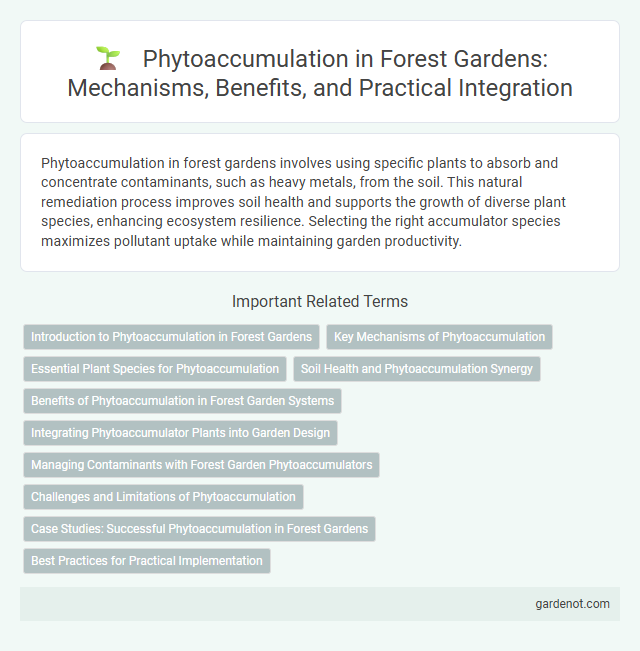Phytoaccumulation in forest gardens involves using specific plants to absorb and concentrate contaminants, such as heavy metals, from the soil. This natural remediation process improves soil health and supports the growth of diverse plant species, enhancing ecosystem resilience. Selecting the right accumulator species maximizes pollutant uptake while maintaining garden productivity.
Introduction to Phytoaccumulation in Forest Gardens
Phytoaccumulation in forest gardens involves the use of specific plants that absorb and concentrate contaminants from the soil, such as heavy metals, through their root systems. This natural process helps in the remediation of polluted soils, improving soil health and fostering sustainable forest garden ecosystems. Selecting hyperaccumulator species tailored to the site's contamination profile enhances the efficiency of phytoaccumulation in forest garden management.
Key Mechanisms of Phytoaccumulation
Phytoaccumulation primarily involves the uptake of contaminants such as heavy metals from soil through plant roots and their subsequent translocation to shoots and leaves. Key mechanisms include root absorption, intracellular sequestration, and binding of metals with cell wall components to reduce toxicity. This process enhances soil remediation by immobilizing pollutants while promoting plant growth in forest garden ecosystems.
Essential Plant Species for Phytoaccumulation
Essential plant species for phytoaccumulation in forest gardens include hyperaccumulators like Brassica juncea (Indian mustard), Pteris vittata (Chinese brake fern), and Helianthus annuus (sunflower), which are highly efficient at absorbing heavy metals from contaminated soils. These plants bioaccumulate pollutants such as cadmium, arsenic, and lead, facilitating soil remediation and promoting ecosystem health. Integrating these species into forest garden designs enhances phytoremediation while supporting biodiversity and sustainable land management.
Soil Health and Phytoaccumulation Synergy
Phytoaccumulation enhances soil health by extracting heavy metals and pollutants from contaminated sites through deep-rooted plants, improving nutrient cycling and microbial activity in forest garden ecosystems. This natural remediation process synergizes with soil biota, promoting increased organic matter breakdown and fostering a resilient, fertile environment essential for diverse plant growth. Combining phytoaccumulation with forest garden design optimizes pollutant removal while sustaining long-term soil vitality and biodiversity.
Benefits of Phytoaccumulation in Forest Garden Systems
Phytoaccumulation enhances forest garden systems by improving soil health through the uptake and storage of heavy metals and pollutants by specific plant species. This natural remediation process reduces soil toxicity, fostering a safer environment for diverse plant and animal life. Incorporating phytoaccumulative plants also supports sustainable agriculture by minimizing the need for chemical interventions and promoting long-term ecosystem resilience.
Integrating Phytoaccumulator Plants into Garden Design
Integrating phytoaccumulator plants into forest garden design enhances soil remediation by naturally absorbing heavy metals and toxins. Species like sunflower (Helianthus annuus), Indian mustard (Brassica juncea), and willow (Salix spp.) efficiently extract contaminants, improving soil health and supporting sustainable ecosystems. Strategic placement of these hyperaccumulators around pollutant-prone zones maximizes their effectiveness while maintaining aesthetic and ecological balance.
Managing Contaminants with Forest Garden Phytoaccumulators
Phytoaccumulation in forest gardens harnesses specific plant species known as phytoaccumulators to extract heavy metals and pollutants from contaminated soil, improving ecosystem health. These plants, including varieties like sunflower, willow, and Indian mustard, absorb and concentrate toxins, facilitating safe removal and reducing environmental hazards. Effective management involves selecting appropriate phytoaccumulator species for local soil conditions to maximize contaminant uptake and enhance the sustainability of forest garden systems.
Challenges and Limitations of Phytoaccumulation
Phytoaccumulation faces significant challenges due to the limited bioavailability of heavy metals in soil, which restricts plant uptake efficiency in forest gardens. Root depth and growth rate variations among species further limit the overall contaminant removal capacity. Toxicity effects on plants and slow accumulation rates also constrain the practical application of phytoaccumulation for effective soil remediation.
Case Studies: Successful Phytoaccumulation in Forest Gardens
Phytoaccumulation in forest gardens has demonstrated significant success in remediating heavy metal-contaminated soils through plants like willow, poplar, and hyperaccumulator species such as Pteris vittata. Case studies reveal that strategic planting of these species in multilayered forest gardens enhances metal uptake efficiency while promoting biodiversity and soil health restoration. Long-term monitoring in sites across Europe and Asia confirms reduced soil toxicity and improved ecosystem functionality through this sustainable phytoremediation technique.
Best Practices for Practical Implementation
Phytoaccumulation in forest gardens involves selecting hyperaccumulator plant species capable of extracting heavy metals and pollutants from contaminated soil, such as mustard greens (Brassica juncea) and sunflower (Helianthus annuus). Optimal implementation prioritizes soil testing to identify specific contaminants, followed by tailoring planting density and harvest intervals to maximize uptake efficiency without disrupting soil structure. Regular biomass removal and proper disposal prevent recontamination, ensuring the forest garden maintains ecological balance and supports long-term soil health.
Phytoaccumulation Infographic

 gardenot.com
gardenot.com